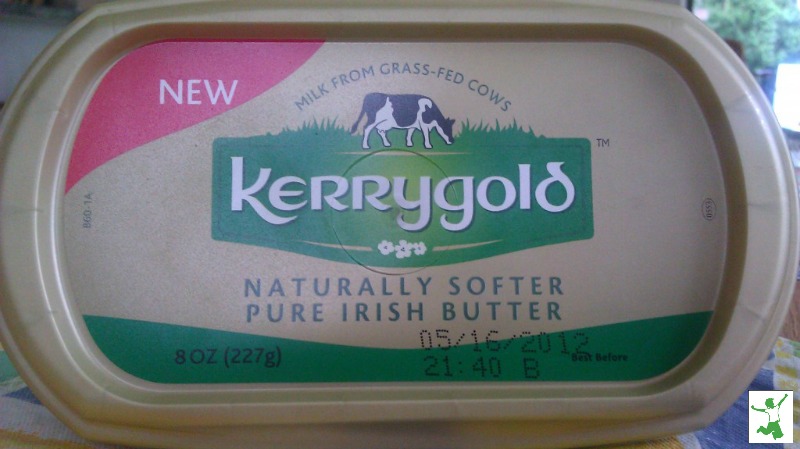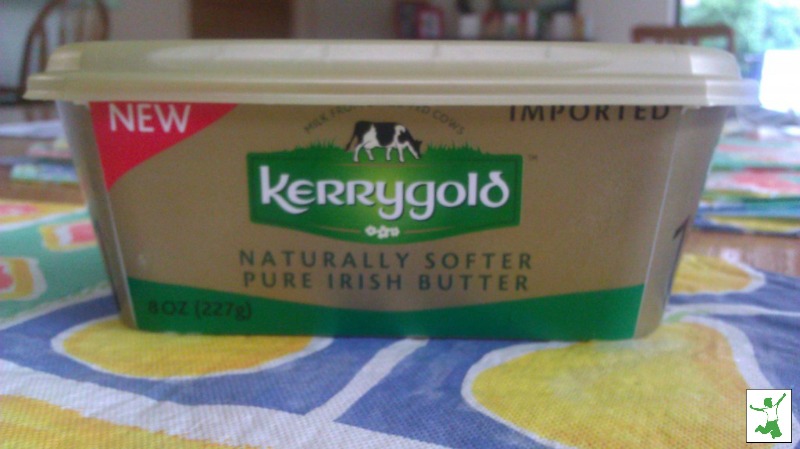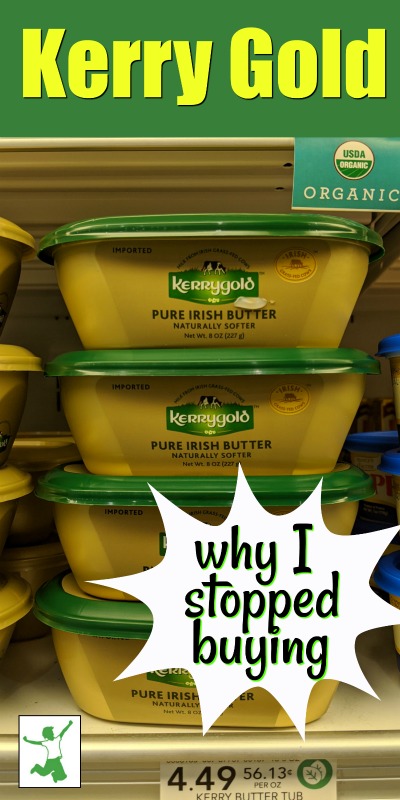Table of Contents[Hide][Show]
Kerrygold is marketed as grass-fed and all-natural, but the tub butter has concerning ingredients, dangers and marketing ploys to consider before buying.

Kerrygold, without question, is probably one of the best store butters you can buy. I myself have been using it for years for cooking.
The milk is from grass-fed cows and even though the cream used to make Kerrygold Butter is pasteurized, it is the best choice available to most folks who do not have access to raw butter from a small farm or who simply don’t want to use their precious raw butter for cooking.
I also know that many of you out there use Kerrygold too. When I conducted a Butter Poll on this blog awhile back, by far the most used butter (out of 1,500 or so total votes) was Kerrygold which received way more votes than even Organic Valley butter.
So what’s the problem?
My husband brought home the “new” Kerrygold butter the other day. On the surface, it looked fine. Nowhere on the outside of the package was there any indication that there was a problem with this butter. Here’s what it looks like.

I got suspicious with the “new” label, however. There’s nothing “new” about butter. That’s what I like about it after all!
Another tip-off that there was a problem lurking was the proclamation on the label that this “New Kerrygold” was “naturally softer”.
When I first saw the “naturally softer” words, I thought that meant that the butter was whipped and hence more spreadable. I don’t know about you, but I don’t want air whipped into my butter. This is a surefire way to get less product and get charged the same price for the privilege if you know what I mean.
I made a mental note to tell my husband not to buy this butter again because it was whipped and not as good a value.
But then, it got way worse…
Is Kerrygold Butter Grass-fed?
I took off the lid to the new Kerrygold package and saw the following words:

I had become a victim of the Big Fast One!
Kerrygold is stealthily selling LOWFAT butter and guess what? You get to pay the same price for the cheaper quality!
NOWHERE on the outside of the label did it say that the butter was low-fat. The ingredients said simply: pasteurized cream and salt the same as the commercialized Amish butter at the supermarket.
I daresay that this marketing ploy will be fooling a lot of folks who desire to buy full-fat grass-fed butter.
It seems that some butter brands have adopted what companies making substitutes for butter have been doing for years.
I have become very tuned in to these labeling tricks and manufacturer games over the years. When it comes to packaging, I double-check the ingredients along with the manufacturing processes every few months. This is even for products that I’ve been buying for years.
But how many people really do this?
Ingredient Bait and Switch
You NEED to be doing this!
Manufacturers are changing ingredients and packaging all the time! The primary intent of these “improvements” is to increase product sales and profitability. Your health is, sadly, of little to no concern in the grand scheme of things.
Reducing the fat content in its butter will skyrocket profits for Kerrygold as they will make the same per unit for the butter and yet be able to sell the skimmed cream to other companies to make ice cream or whatnot thereby increasing revenue substantially.
If you buy Kerrygold, I’m not telling you to stop buying it. I’m only telling you to beware of this new packaging nonsense and be sure what you buy is what you intend: full-fat butter!
By the way, if you are wondering why I love full-fat butter, you might want to educate yourself on the low-fat scam by learning about the history of butter vs margarine in the United States.
As for me, I will be returning this product to the store for a full refund. It is falsely advertised after all. I had no way of knowing it was a low-fat product until I opened it.
Manufacturer Response
I received this email from Kerrygold following the widespread sharing of this article. I find it very hard to believe that my blog suddenly brought this packaging error to their attention.
Do they have NO ONE on the production line in charge of quality control? This was not a difficult problem to identify. Could we have a bit of spin going on here? Perhaps so.
Dear Sarah,
Your blog has brought to our attention a packaging error of which we were unaware. While Kerrygold does sell a Reduced Fat & Sodium Butter the pack you show on your blog is 100% full fat butter which has been packed with the incorrect inner seal. There is no deliberate intent on our part to mislead our valued consumers or to misrepresent our product although we regret the confusion this is clearly creating.
We are working to identify how much product has been released into the market with the incorrect packaging so that we can replace it as soon as possible. In the meantime we would appreciate your assistance in clarifying the misunderstanding to your readers. We would love to provide further clarity — our email is [email protected] — and we are happy to answer any specific questions you and your readers may have in relation to the product.
With thanks & regards,
The Kerrygold Team
Why I No Longer Buy Kerrygold
I wanted to let all of you know that I no longer buy even the traditional Kerrygold brick butter in foil packaging. Why? A good friend visited Ireland and traveled extensively to a number of grass-based dairy farms.
This credible source told me that while the cows that provide cream for the Kerrygold butter are definitely on pasture and hence “grass-fed”, they receive supplemental GMO animal feed as well especially during the winter months. The local community and citizenry in Ireland concur and will tell you as much if you are in the area.
So, the word on the street is that Kerrygold is not legitimately pastured either.
Butter from cows that get GMO feed introduces the very real possibility of Roundup residue in the butter.
Thanks but no thanks!
While I have not been able to confirm this story 100%, I trusted the credibility of the information enough to permanently switch to another brand (I currently use this one).
I use this butter for cooking in addition to the homemade pastured raw butter I make for non-cooking purposes.
I also no longer recommend Kerry Gold in my Shopping Guide.
What about Organic Valley butter as an alternative to Kerry Gold? While I am not happy about Organic Valley’s policy that disallows member farmers to sell raw milk on the side to their community (treating them more like medieval serfs than the independent business owners that they are), I find this less onerous than deceptively feeding animals GMO feed without clearly informing the end consumer.









I have been buying my (regular) Kerry told at aldi. But lately I’ve noticed it isn’t as dark yellow- as grass-fed SHOULD be. Don’t know if it’s just Aldi?
Aldi is just a retailer. If it isn’t dark yellow, that is the fault of Kerry Gold. I agree that the quality of Kerry Gold has tanked in recent years, which is why I stopped buying it.
Cathy, your comment makes me feel a little less crazy/paranoid. Since I posted originally, I’ve just been using the Kirkland Organic butter which is definitely not grass fed, but it actually looks and tastes like real butter. My acne cleared up within the first couple of days, my reflux went away, and the the random nausea I was having on and off is gone. My daughter’s skin has cleared up also, and my son is not complaining about having itchy skin anymore. My wedding ring is so loose I feel like it might fall off so I’m thinking I’ve been fighting inflammation for a while now. I guess it could all be coincidence, but I’m fairly convinced that there was something wrong with that butter, maybe even for a longer time than just this last batch, since that’s really the only thing that I’ve changed.
I’v been using kerrygold for years. Last purchase from Costco does not taste right, or melt the same in my mouth. Went on a search to see if others are finding the same problem. I think it is margarine.
Not sure if this is at all related, but my last batch of Kerrygold block butter was just…weird. it looked and tasted like margarine, (I’ve been buying it for years and it has never tasted off, and it was way too soft straight out of the fridge). It was gold label from Costco. I wrote it off at the time as seasonal variation, but some autoimmune symptoms started cropping up that I haven’t had sice eating a real food diet, and my acne flared up like it hasn’t in years. Just wondering if anyone else has noticed anything, or if it was just an isolated batch and/or it really was just seasonal variation.
This is not Kerry Gold bars of butter. Normally you buy it in blocks. This looks like their “impression” of margarine. I’m not 100% sure what is in it, but any butter which is “smoother” or “spreadable” normally has oils which keep it softer than real butter, which are a key giveaway to stay away from it.
Sarah, very enlightening article and put me on the right track to do some further research on butter which I am now happy to eat without worry. The reason I was concerned is the greasy aftertaste in the throat I experience after eating butter in the morning. Whenever I am cooking any greasy food I always add some apple cider vinegar to breakdown the fats for my digestion but wanted to find something I could eat or drink that would ameliorate that sticky greasy taste after eating raw butter on bread. Drinking vinegar just soured my stomach. Any ideas? Thanks.
I think you’ll find that the use of GMO supplements in Irish agriculture and the wider EU zone is far more regulated than anywhere else in the world. Note: for it not to be included in the ingredients, it must be less than 0.9% volume.
Labelling of foodstuff in EU is incredibly strict and as a person who has travelled and lived in quite a few countries I have a high regard for my food providence and this regulation. I have always used Kerrygold (where I can get it) and will continue to do so.
For further factual information: Please check out the Irish food safety authority fsai.ie and agriculture.gov.ie
Thank you soooo much for this information! I have been looking into the Bulletproof Diet. Asprey talks ups Kerrygold all over the place.
I can’t believe Kerrygold is cutting corners! Is nothing sacred??
Good thing is that I found your blog and I will be subscribing.
I’m surprised to hear about the dairy cows in Ireland being fed gmo feed. I was there last October for the first time and was quite impresssd at the advance in food choices over the US. If you are gluten intolerant, there are hundreds of places to get a meal. I use stevia and could find it everywhere. I cannot in Western NY. I saw all the cows and sheep grazing when I travelled from Dublin to the West coast. I was interested in their farming as I have a Dexter cow ( due to calve for the first time any day now) and Shetland sheep. Ask of which are pasture/organic hay and organic grain fed. If you grain a dairy or lactating cow too much, it can cause bloat and can kill the cow. With the near year round grazing, there must be many farms that do not invest in grain. Also, Ireland is, unfortunately, a part of the EEC and must hold to many strict guidelines. One thing about Europe is the lack of the use of pesticides, etc. Would it make sense then to use gmo in your feed? I think it is hearsay. I also think companies can make mistakes, own up to them, and still be respected. I also do not use anything fat free but will stick with the Kerry Gold butter esp for my bullet proof coffees. American butter, organic, Amish or whatever does not taste as good. I will have my own butter soon regardless. Thanks for your desire to see people eat and live healthier.
what about the lurpak butter
That is conventional butter. I am quite sure GMO feed is used for those cows … also they are not pastured anyway.